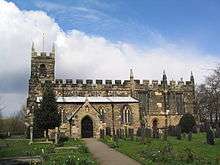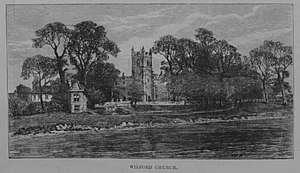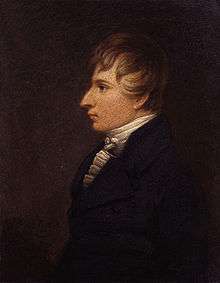St Wilfrid's Church, Wilford
St Wilfrid's Church, Wilford is a Grade II* listed parish church in the Church of England[1] in Wilford, Nottinghamshire, England.
| St Wilfrid's Church, Wilford | |
|---|---|
 St Wilfrid's Church, Wilford | |
| 52°56′5.29″N 1°9′32.57″W | |
| Location | Wilford |
| Country | England |
| Denomination | Church of England |
| Website | wilford.org/church/ |
| History | |
| Dedication | St Wilfrid |
| Architecture | |
| Heritage designation | Grade II* listed |
| Administration | |
| Parish | Wilford |
| Deanery | West Bingham |
| Archdeaconry | Nottingham |
| Diocese | Diocese of Southwell and Nottingham |
History
The church dates from the late 14th century. It is considered to have been founded by Gervase de Wilford around 1361. The chancel dates from 1430 and the clerestory and tower later in the 15th century. The aisles were rebuilt in 1890-1891 when a vestry was also added. The nave was re-roofed in 1935, and the chancel in 1960.
The churchyard contains war graves of eight soldiers of World War I and an airman of World War II.[2]

The churchyard also contains the grave of Captain John Deane, an adventurer and mercenary, lived in the village. His ship The Nottingham Galley sank off the coast of Boon Island, New England in 1710. Deane and his crew, trapped on the island, were forced to cannibalise a corpse shortly before being rescued. Deane subsequently served in the Russian navy under Peter the Great, and retired to Wilford in 1736.
In the churchyard is a gazebo built in 1757. In 1980 it was restored after a fire four years earlier. Located next to the River Trent the basement was at one time used as a mortuary.[3]
In 1915 part of the parish was divided to create St Faith's Church, Nottingham.
Benjamin Carter

Benjamin Carter (?-1732) was Rector of St Wilfrid's from 1694 to 1732. Carter was a great benefactor for the local community and congregation. He endowed the present church school, South Wilford CofE Primary School; built the rectory c.1720 with its barn, stables, and dovecot; and left money for various charitable purposes.[4]
The Carter's Educational Foundation continues to be responsible for the endowment left by Carter in a Deed dated 1727 and in his will.[5] By his will he gave £200 to erecting a school, and convenient lodging, and £400 as augmentation to the Charity. The foundation's priority remains the successful running of South Wilford Endowed Church of England Primary School. However, the foundation also supports the Education, and the Social and Physical Development of the young people of the Ancient Parish of Wilford through individual and group grants.
Carter also gave Communion Plate to the church in 1717. Some of it is still in use, but several items were stolen in 1974. They have subsequently been replaced by modern silver.
The rectory was privately bought in the 1990s whilst a new rectory was built adjacently. The church paddock flanked by the Church, Old Rectory and New Rectory also includes the dovecote and outhouses built under Carter in addition to the Church Hall and Benjamin Carter Memorial Hall, named in his honour.[6][7]
Carter died in 1732, and was buried in the chancel, but no stone marks his resting place.
Henry Kirke White

Henry Kirke White (21 March 1785 – 19 October 1806) was an English poet. He died at the young age of 21. He lived in Wilford at the crossroads, opposite Wilford House between 1804 and 1805. He drew inspiration for much of his poetry from Wilford and the surrounding area.[8]
He wrote many of his poems in the gazebo which stands in the grounds of St Wilfrid's Church. Here he wrote:-
Here would I wish to sleep, this is the spot
Which I have long marked out to lay my bones in.
Tired out and wearied with the riotous world,
Beneath this yew would I be sepulchred.[9]
Kirke White died whilst studying at St John's College, Cambridge in 1806. He was buried in the church of All Saints Jewry, Cambridge, which stood opposite the gates of St John's College. St Wilfrid's Church features two memorials to Kirke White: one is a marble plaque inside the nave, the second is a memorial stained glass window, c1870, by O'Connor.[10]
Organ
The organ dates from 1878 by Henry Willis. A specification of the organ can be found on the National Pipe Organ Register.[11]
References
| Wikimedia Commons has media related to St Wilfrid's Church, Wilford. |
- The Buildings of England: Nottinghamshire: Nikolaus Pevsner.
- "Cemetery Details". CWGC. Retrieved 2015-07-31.
- "Wilford St Wilfrid". Soithwell and Nottingham Church History Project. Retrieved 3 November 2013.
- Wright, A.(1978) Wilford Church Guide.
- Will of Benjamin Carter, Rector of Wilford, Nottinghamshire. Ref: PROB 11/656/142. 19 January 1733. Held in The National Archives, Kew
- Wright, A. (1978) Wilford Church Guide.
- St Wilfrid's Church, about us. https://wilford.org/page/86/about-us
- http://www.thorotonsociety.org.uk/publications/articles/kirkewhite.htm
- http://www.thorotonsociety.org.uk/publications/articles/kirkewhite.htm
- http://southwellchurches.nottingham.ac.uk/wilford-st-wilfrid/hlisting.php
- "Nottinghamshire Wilford (NPOR) V2.20". Npor.org.uk. Retrieved 2015-07-31.